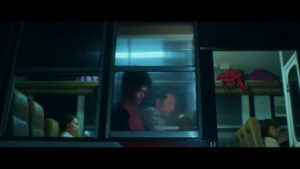
Impressions of a boy’s demonic transformation
By Brontë H. Lacsamana, Reporter
Movie Review
The Gospel of the Beast
Directed by Sheron Dayoc
Cinemalaya Independent Film Festival
THE CRIMINAL underworld has featured heavily in Philippine cinema, through detailed glimpses of the poverty that drives people to it and the gritty, violent fates that befall those corrupted by it.
The Gospel of the Beast (2024) situates a character study of a 15-year-old boy in this harrowing landscape. Director Sheron Dayoc brings the audience face-to-face with Mateo, who struggles with the destructive realities of life and death.
Playing this doomed character is Jansen Magpusao, whose acting range is on full display as he transforms from traumatized teen to stone-cold killer in a visual feast that makes use of a dreamy style rather than a realistic one. After accidentally killing a friend, the boy seeks help from his uncle (played by Ronnie Lazaro), who serves as the bridge to a world of violence.
Because the film centers primarily on how Mateo is distorted into a man with beastly morals, there is not much else to discuss in terms of the other characters and events that take place. Scenes tensely edited together, some gruesome and some a seemingly innocent calm before the storm, form a moody playground for Mr. Magpusao to show off his acting chops.
At this point in his career, he proves he has the remarkable ability to embody the struggles of the disenfranchised Filipino youth, from downtrodden hopelessness in the 2019 film John Denver Trending, to a gradual demonic transformation here in The Gospel of the Beast. The most notable thing this film does is bring forth his ability to convey inner turmoil.
While not as narratively strong as Mr. Dayoc’s previous film Women of the Weeping River, it arguably has much stronger visual storytelling. The tightly edited montages present warped reflections of faces on broken mirrors and an unflinching look at the violent scenes and tendencies that become Mateo’s refuge. It’s a dark, impressionistic approach, deciding not to flesh things out and relying on images and actions to push the character’s evolution forward — a shame since it may have needed a bit of balance to the overall brooding tone and pace.
The notes of religious fervor that treat violence as the only way of life in the margins of Philippine society are well-executed. Those who’ve watched quite a bit of Lino Brocka’s oeuvre will notice references to his work, mainly the opening scene that depicts pig slaughter similarly to 1976’s Insiang. Like how the slaughterhouse where Mateo and his uncle work at shows more meat being reeled in, this film enters the realm of Philippine cinema with more of the same that we’ve already seen, albeit with a different treatment.
Mr. Magpusao as Mateo sells us his beastly transformation with mere facial expressions (a sign of a long, remarkable career ahead), but The Gospel of the Beast is focused too much on an aesthetic vision to provide details that will help the audience dive deeper. The other characters in the cast, for example, are unnamed and completely forgettable. The cinematography and editing are striking, full of rich textures and filmic pacing, but always so concerned with the character’s perspective that the world around him feels almost unreal (even though it is real, the film shot entirely in Western Visayas, with the cast actually hailing from that region!).
Mr. Dayoc, who started off as a documentary filmmaker, may have played with a more stylistic approach here, but beneath all that is his advocacy of tapping into the unflinching, cyclical reality of violence in the Philippines, and how it makes beasts out of young boys.
For that, The Gospel of the Beast was a fine choice for the opening film of the 20th edition of the Cinemalaya Independent Film Festival, where Mr. Dayoc made his debut in 2010 and Mr. Magpusao in 2019. Prior to that, the film was well-received in film festivals in Tokyo and Ho Chi Minh.
It echoes the indie scene’s tendencies to tackle similar topics yet attempt to do something different each time — all of varying quality, all turning to the film festival circuit to flourish, all in the name of defining modern Philippine cinema.
Rated R-16
The Cinemalaya 2024 film festival will have 10 full-length and 10 short films in competition. The festival runs from Aug. 2 to 11 at Ayala Malls Manila Bay in Parañaque City. Counting the other exhibition films, retrospectives, and premieres, the festival’s lineup this year totals 200 films. For more details including the screening schedules, visit the CCP and Cinemalaya websites and social media pages.



